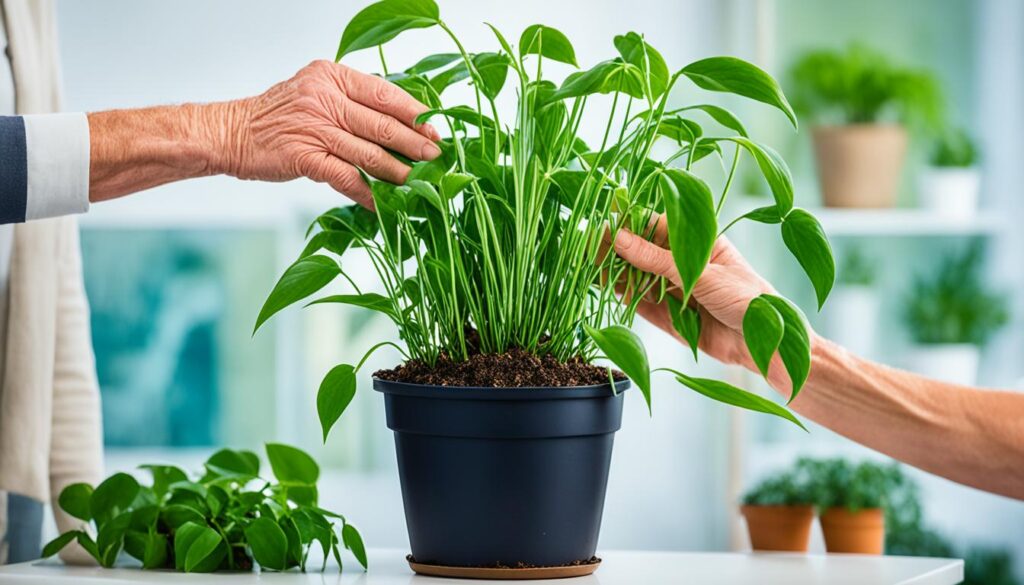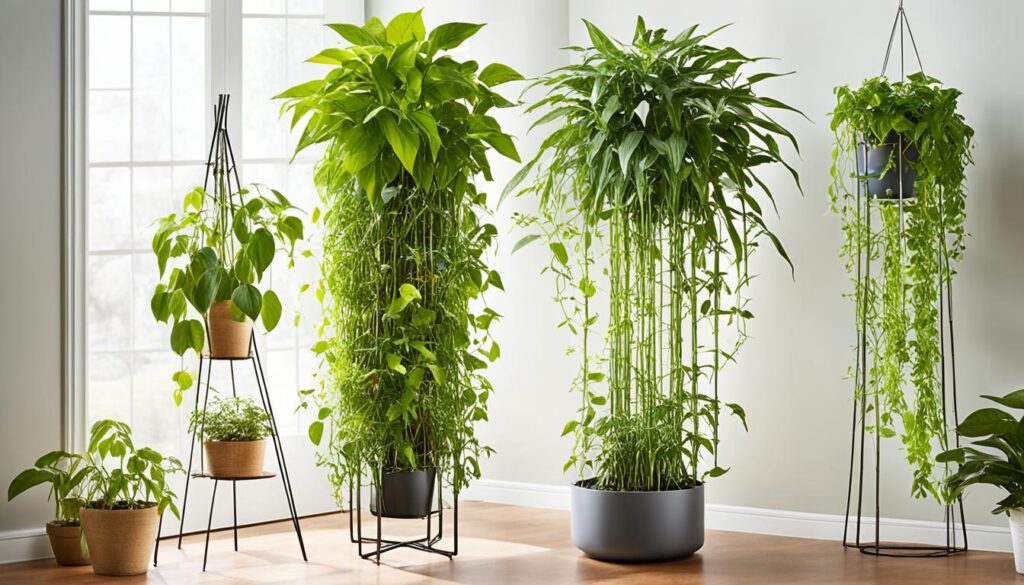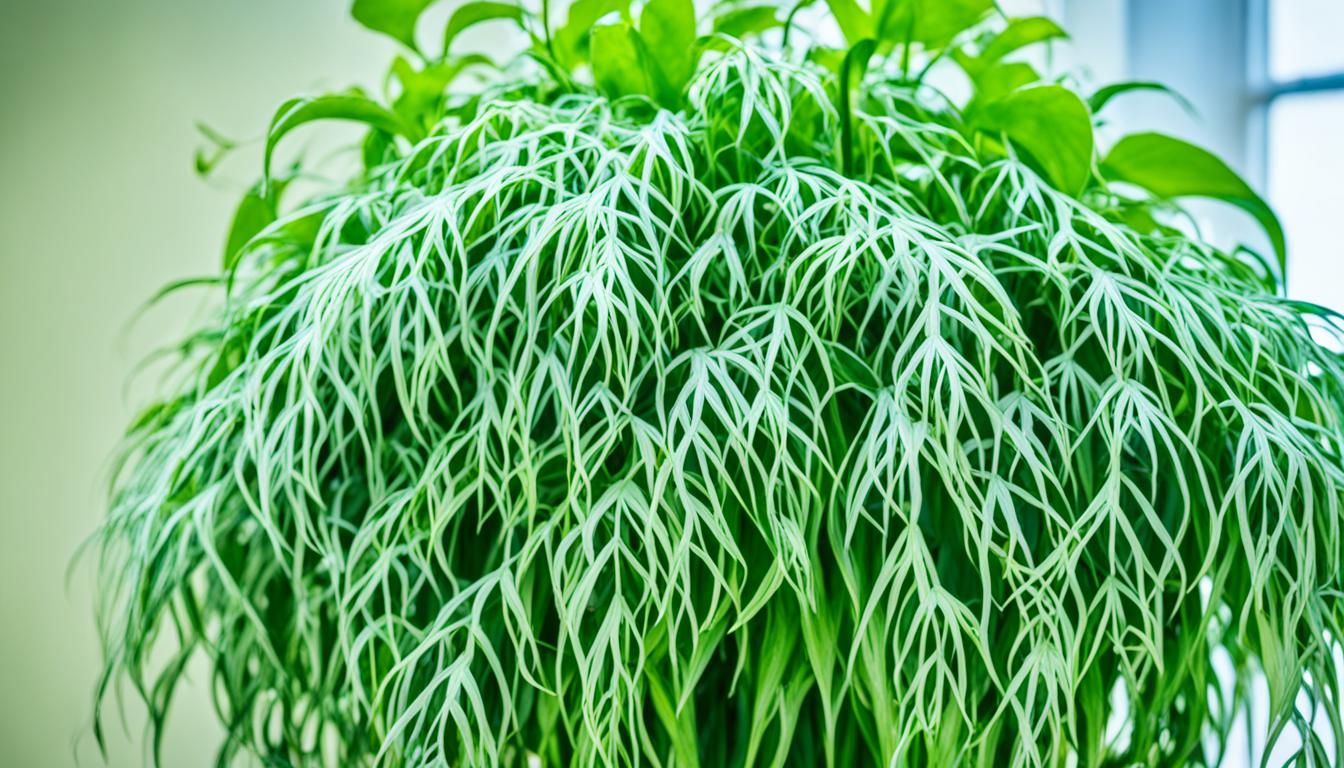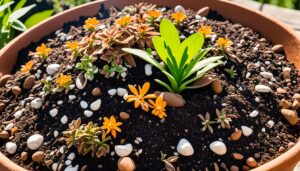Have you ever seen your indoor plants with drooping stems? This can be tough for even the best plant lovers. But don’t worry, we’ve got you covered! We’ll look at why stems droop and how to fix it. You’ll learn how to make your plants healthy again.
Did you know the secret to fixing droopy indoor plants is knowing what they need? By understanding what makes plants unhappy and fixing the problem, you can make them look great again. Are you ready to become a pro at taking care of plants?
Understanding the Signs of an Unhappy Indoor Plant
Knowing how to spot an unhealthy indoor plant is key to fixing it. Watch your plant closely to find out what’s wrong. Look for wilting leaves, drooping stems, yellowing or browning foliage, and roots circling the container.
Wilting Leaves and Drooping Stems
Wilting leaves and drooping stems mean your plant is struggling. This could be from overwatering or underwatering. Check the soil moisture and adjust your watering to help your plant.
Yellowing or Browning Foliage
Yellowing or browning leaves signal a problem with your plant. It could be from not getting enough nutrients, disease, or stress. Look at the leaves and stems to figure out what’s wrong and fix it.
Roots Circling the Container
If you see roots circling the container, your plant is root-bound. This means it’s not growing well and might not get enough nutrients. Move it to a bigger pot with fresh soil to help it grow.
Keep an eye on your indoor plants to catch problems early. This way, you can fix them fast and keep your plants happy and healthy. A little care makes a big difference.
“The key to a healthy indoor plant is understanding its needs and responding quickly to any signs of distress.”
Diagnosing the Cause of Drooping Indoor Plant Stems
Figuring out why your indoor plant’s stems are drooping is key to fixing it. We’ll look at the main reasons – overwatering and root rot, underwatering and dehydration, and pot-bound roots causing nutrient deficiency.
Overwatering and Root Rot
Overwatering is a big reason for drooping stems. When the soil stays too wet, roots get waterlogged and rot. This root rot stops the plant from getting water and nutrients, making stems and leaves droop. Watch for soggy soil, yellow leaves, and a bad smell from the potting mix.
Underwatering and Dehydration
Not watering enough can also make stems droop. Without enough moisture, the plant can’t pull water up, leading to wilted leaves and stems. The soil looks dry and cracked, and leaves might curl or turn brown at the edges.
Pot-Bound Roots and Nutrient Deficiency
If your plant’s roots are pot-bound, circling the pot, it limits the plant’s access to nutrients and water. This nutrient deficiency makes stems weak and droopy. Check the roots by gently taking the plant out of its pot to see if they’re tangled and dense.
By watching your plant closely and checking the soil, you can figure out why the stems are drooping. Then, you can fix it to bring your indoor plant back to life.
| Cause | Symptoms | Solution |
|---|---|---|
| Overwatering and Root Rot | Soggy soil, yellowing leaves, foul odor | Adjust watering, improve drainage, treat root rot |
| Underwatering and Dehydration | Dry, cracked soil, wilting, curling leaves | Water thoroughly, increase humidity |
| Pot-Bound Roots and Nutrient Deficiency | Tangled, dense root system, weak stems | Repot, add fresh potting mix, fertilize |
Reviving Drooping Indoor Plant Stems
When your indoor plants start drooping, it’s a sign of a problem. Luckily, you can fix this with some simple steps. These steps will help bring your plants back to life.
Adjusting Watering Practices
Improper watering is a common reason for drooping stems. Changing how you water can greatly improve your plants’ health. Check the soil often to see if it needs water. Too little water can dehydrate your plants, while too much can cause root rot.
Repotting and Pruning Techniques
If your plant’s roots are too crowded, it might need a new pot. Fresh soil and more space can help. Cutting off dead leaves also helps your plant focus on growing new, healthy parts.
Pest Control and Environmental Checks
Pests and bad conditions can make stems droop too. Look for pests like aphids and deal with them. Make sure your plants get enough sunlight, moisture, and air to stay healthy.
Fixing drooping stems involves better watering, repotting, pruning, and checking the environment. These steps will help your indoor plants look vibrant again.

Drooping Indoor Plant Stems: Common Culprits and Solutions
Dealing with drooping indoor plant stems can be frustrating. But, knowing the common causes and solutions can help. Let’s look at the main reasons and how to fix them.
Overwatering: The Stealthy Culprit
Overwatering is a big reason for droopy stems. When plants get too much water, their roots lack oxygen. This leads to root rot and wilting stems and leaves. To fix this, change your watering habits. Make sure the soil dries out a bit between waterings.
Underwatering: When Thirst Takes Over
Underwatering can also make plants droop. Dry soil makes plant cells dehydrate, causing stems to look limp. To fix an underwatered plant, water it well until the soil drains from the pot. Then, keep watering regularly.
Nutrient Deficiency: Feeding for Flourishing
Not getting enough nutrients is another reason for droopy stems. Plants need minerals and vitamins to stay healthy. Try using a gentle, water-soluble fertilizer to give them a boost.
Environmental Factors: Optimize for Success
Things like temperature, humidity, and light can also cause droopy stems. Make sure your plants are in the right spot. They might need bright sunlight or more shade. Adjusting their environment can really help.
By fixing the common causes of droopy stems, you can help your plants bounce back. With a bit of troubleshooting and care, your indoor plants can stay healthy and bright.

Conclusion
Reviving drooping stems in your indoor plants takes a full approach. Start by knowing the signs of a sad plant. Then, fix the problems with the right care.
With the right care, even dying plants can come back strong. They can make your home or office look great.
As a plant parent, watch your plants closely and act fast when needed. Know the main reasons for drooping stems like too much water, not enough water, and not enough nutrients. This way, you can care for your plants better.
Indoor plant care is a journey, but it’s worth it for a beautiful, healthy space. Whether you’re new to plants or have been growing them for years, this article can help. Use these tips to fix drooping stems and become an expert in indoor plant care.
Start your journey and let your indoor plants thrive. They’ll bring beauty and peace into your home.
FAQ
What are the common signs of an unhappy indoor plant?
Signs of an unhappy indoor plant include wilting leaves and stems, yellowing or browning leaves, and roots circling the container. By closely inspecting your plant, you can spot these issues.
What are the most common causes of drooping indoor plant stems?
Drooping stems can come from overwatering and root rot, underwatering and dehydration, or pot-bound roots causing nutrient lack. Look at the soil, roots, and overall look to figure out the issue.
How can I revive a drooping indoor plant?
To revive a drooping indoor plant, adjust your watering, repot in fresh soil, and prune dead foliage. Also, check for pests and ensure the right environment to boost its health.
What are the most common culprits behind drooping indoor plant stems?
Common culprits include overwatering, underwatering, nutrient lack, and environmental issues like low light or wrong temperature. Knowing the issue and fixing it is crucial for your plant’s recovery.
How can I prevent future issues with my indoor plants?
Prevent future problems by having a regular watering schedule, using the right soil and pot, and providing proper light and temperature. Also, check for pests and nutrient needs to keep your plant healthy and prevent drooping.




